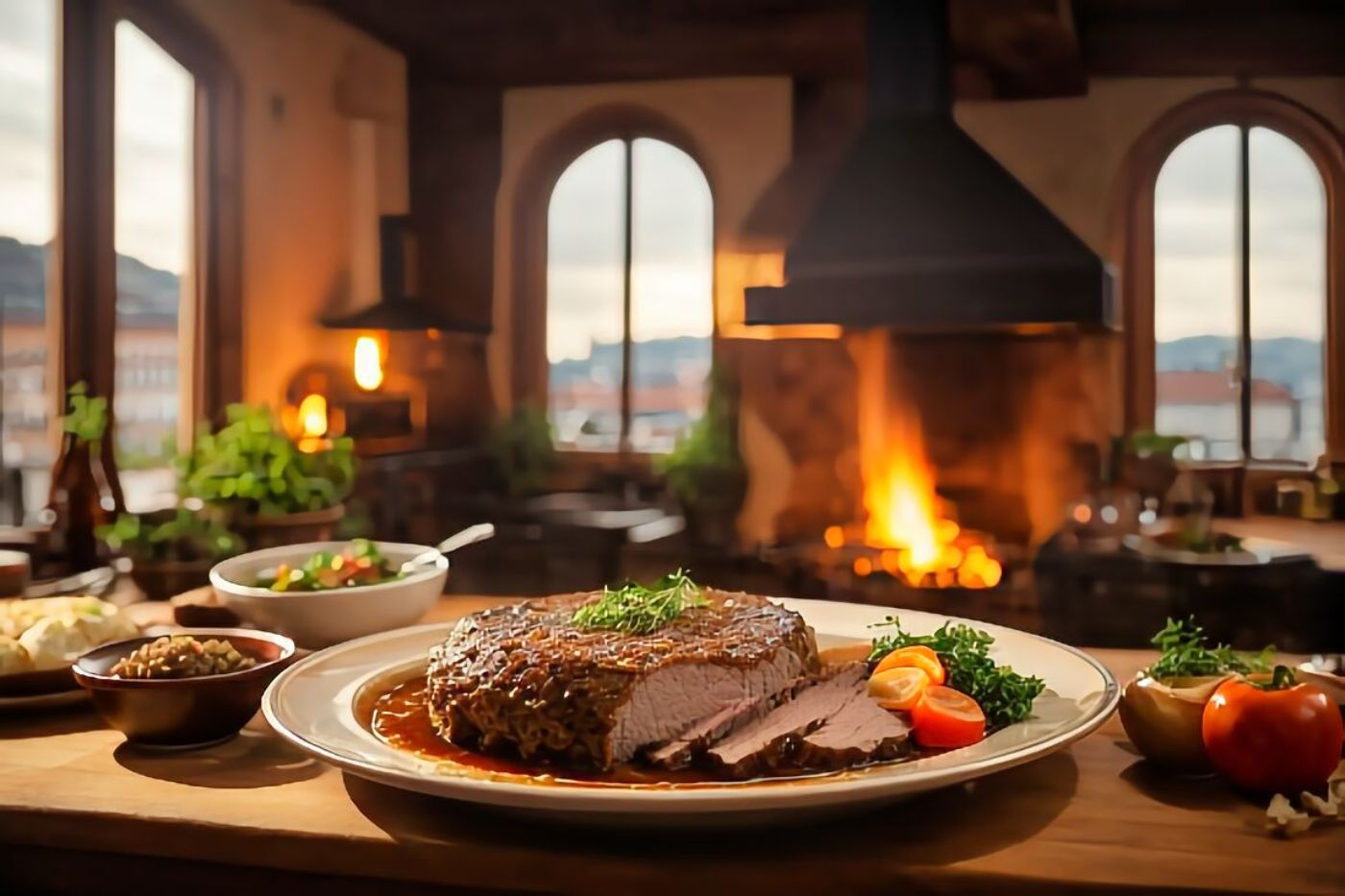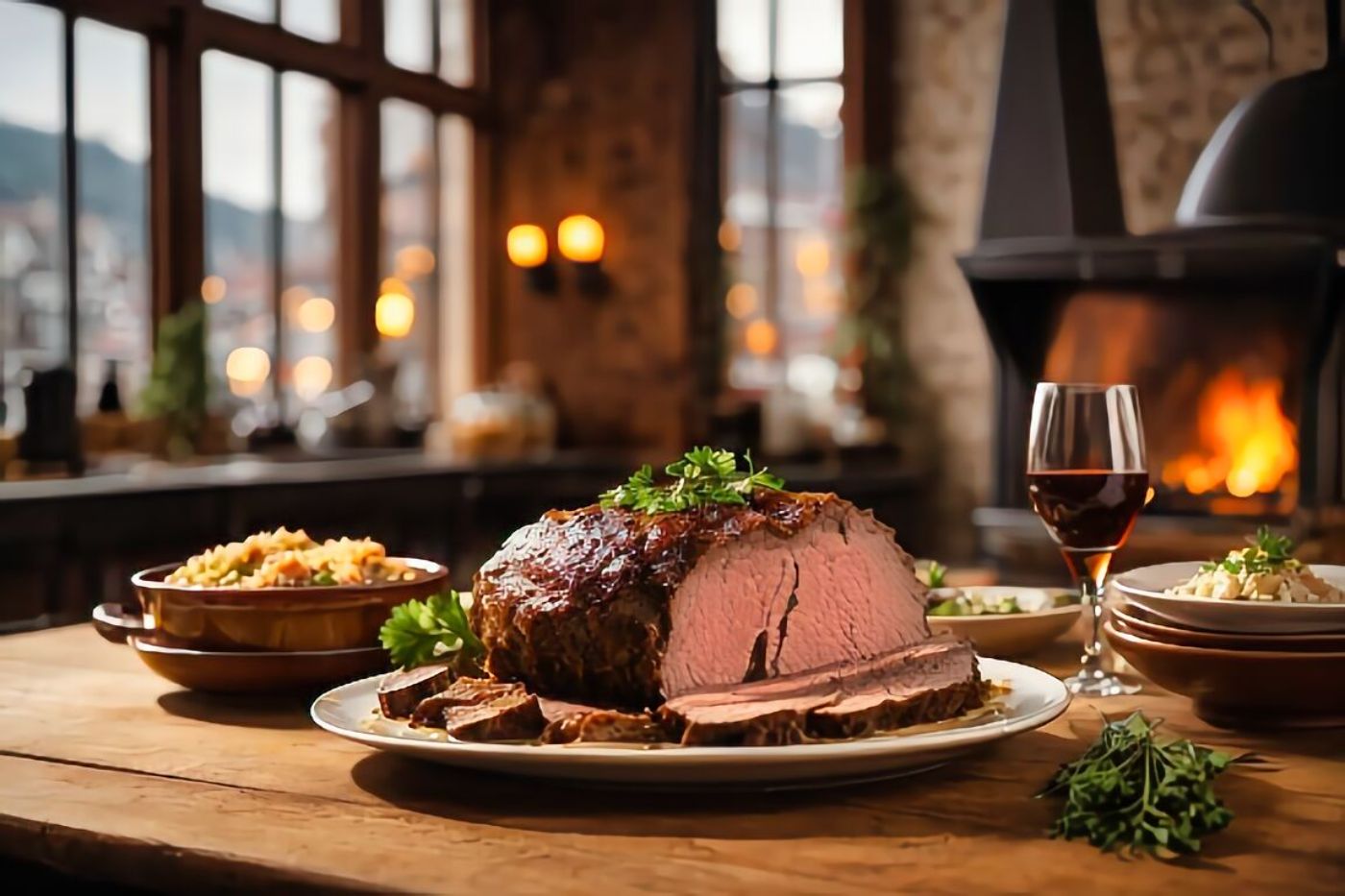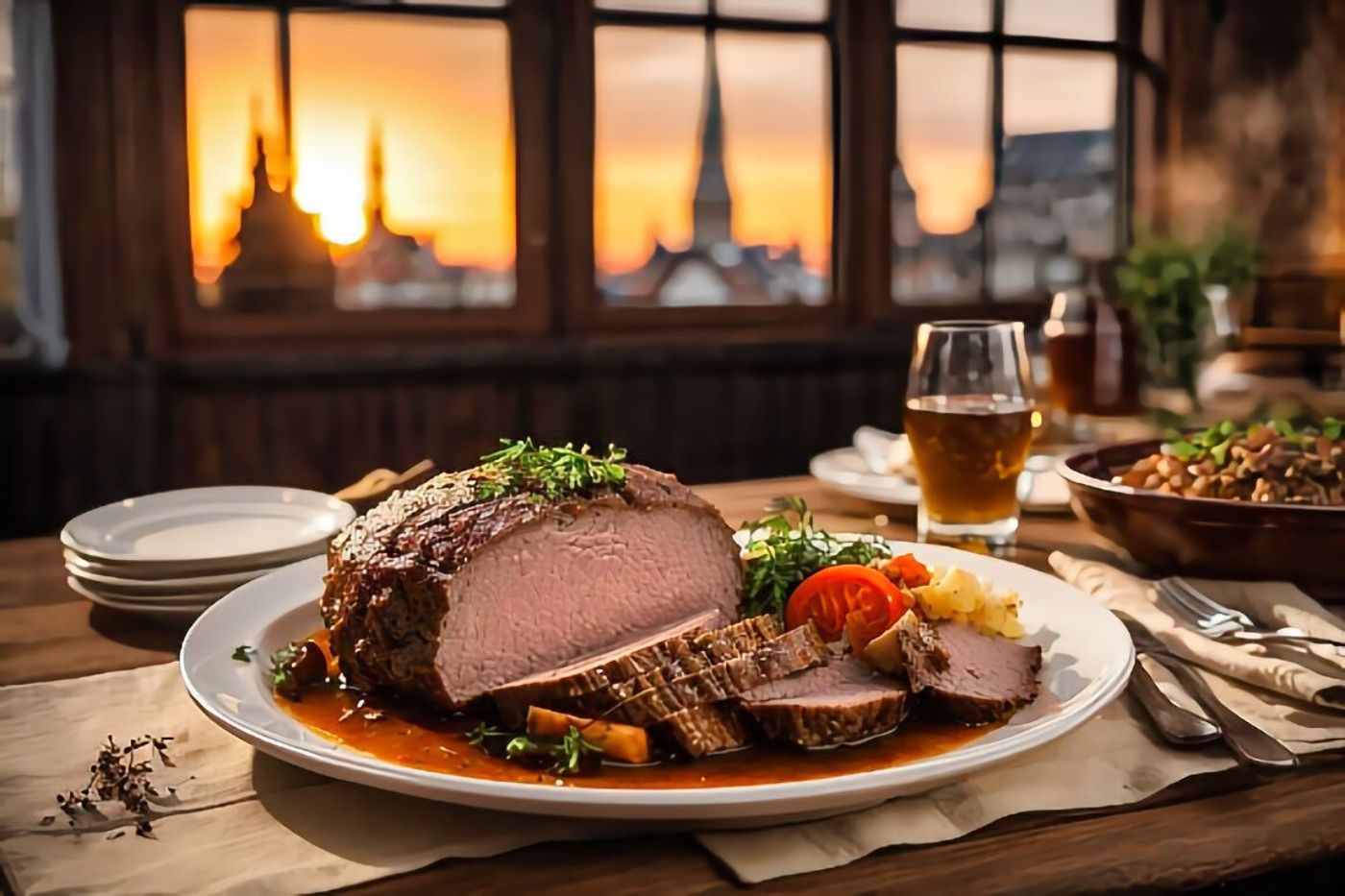
The German Sauerbraten Recipe is a beloved culinary tradition that hails from Germany, renowned for its distinctive blend of sour and sweet flavors. This flavorful dish centers around marinated and slow-cooked meat, typically beef, although other meats like pork, lamb, or even traditionally horsemeat have been used in various regions of Germany.
At the heart of this dish is the marination process, which gives Sauerbraten its unique taste. The meat is marinated for several days in a mixture of vinegar or wine, water, and a medley of aromatic spices. The marinating period allows the meat to absorb the flavors deeply, resulting in tender, succulent, and flavorful meat.
The name “Sauerbraten” translates to “sour roast” in English, reflecting the tangy and slightly sweet taste that characterizes this dish. The sourness primarily comes from the marinating liquid, which typically includes vinegar or wine. In contrast, the sweetness is achieved through the addition of ingredients like brown sugar or gingersnaps to the sauce during the cooking process.
Want more ideas for Your German Recipe Box?
A lot of great options are in these posts!
You May Want to Join The OBE Recipe Group World Recipes With Our Big Escape
Share your own recipes in our Facebook Group. Find recipes from all over the world. Learn more about International Cuisine and how you can surprise your family with new and exciting foods from all over the world.
For More Photos Visit Our Instagram at World Recipes Daily
The marinated meat is slow-cooked to perfection, usually in an oven, until it becomes fork-tender and infused with the rich, complex flavors of the marinade. The dish is often served with a robust gravy made from the cooking juices, thickened with the crushed gingersnaps or a roux, and served alongside side dishes like red cabbage, potato dumplings, or boiled potatoes.
Sauerbraten is not only cherished for its remarkable taste but also for its role in German culinary history and cultural heritage. It has been a staple in German households for centuries, passed down through generations. Each region of Germany has its own variation of the dish, with slight variations in ingredients and preparation methods.
Today, the German Sauerbraten Recipe continues to be a symbol of German cuisine, both in its homeland and abroad. It is often enjoyed during special occasions and festive gatherings, reflecting the warm and comforting essence of traditional German cooking.
The German Sauerbraten Recipe is a time-honored German dish renowned for its distinct sour and sweet flavor profile. This flavorful concoction of marinated and slow-cooked meat showcases the rich culinary history of Germany, with regional variations adding to its cultural significance. Whether enjoyed with family or in a restaurant, Sauerbraten remains a cherished part of German culinary heritage.
German Sauerbraten Recipe Health Benefits:
The German Sauerbraten Recipe, while delicious, is not typically associated with specific health benefits. It is a hearty and satisfying dish that provides essential nutrients, but it is also relatively high in calories due to the marinating process and cooking methods. The marination of the meat often involves vinegar or wine, which can contribute to the sour taste of the dish.
In terms of nutritional content, the German Sauerbraten Recipe includes protein from the meat, along with carbohydrates from any side dishes like potatoes or dumplings. It may also contain vitamins and minerals from the various herbs and spices used in the marinade. However, it’s essential to be mindful of portion sizes, as this dish can be calorie-dense.
In conclusion, the German Sauerbraten Recipe is a traditional German dish known for its unique sour and sweet flavors. Germany has a rich culinary history that has evolved over time, with modern German cuisine incorporating global influences. While the Sauerbraten may not be associated with specific health benefits, it offers a hearty and satisfying dining experience.

How To Make Our German Sauerbraten Recipe
Ingredients (8 Servings)
Marinade
2 onions, large chopped
2 carrots, large chopped
1 leek, large chopped
3 cloves garlic, minced
2 sprigs thyme
2 sprigs rosemary
2 bay leaves
8 juniper berries
6 whole cloves
10 whole black peppercorns, cracked
2 ½ tsp kosher salt
1 tbsp sugar
2 cups red wine
1 ½ cups red wine vinegar
1 cup beef broth
½ cup raisins, golden optional
Roast
3-4 lbs. beef, chuck roast or rump roast
2 tbsp vegetable oil
10 cookies, gingersnap crushed
Instructions
1. Marinade Preparation.
a. In a large bowl, combine chopped yellow onions, carrots, leek, minced garlic, thyme sprigs, rosemary sprigs, bay leaves, juniper berries, whole cloves, cracked black peppercorns, kosher salt, and sugar.
b. Pour red wine, red wine vinegar, and beef broth over the mixture.
c. Add optional golden raisins if desired.
d. Stir well to ensure all ingredients are evenly mixed.
e. Cover the bowl and refrigerate the marinade for at least 24 to 48 hours, allowing the flavors to meld.
2. Meat Marination.
a. Place the beef chuck roast or rump roast into a large, resealable plastic bag.
b. Carefully pour the prepared marinade over the meat.
c. Seal the bag, ensuring all excess air is removed to maximize contact between the meat and marinade.
d. Refrigerate the meat in the marinade for at least 3 to 5 days, turning it occasionally to ensure even marination.
3. Preheat Oven.
a. Preheat your oven to 325°F (160°C).
4. Roasting the Meat.
a. Remove the marinated meat from the plastic bag, allowing any excess marinade to drip off.
b. In a large ovenproof Dutch oven or roasting pan, heat vegetable oil over medium-high heat.
c. Sear the meat on all sides until it develops a golden-brown crust, approximately 4-5 minutes per side.
d. Once seared, remove the meat from the pan and set it aside.
5. Creating the Sauce.
a. In the same pan, add the crushed gingersnap cookies to the remaining marinade and stir well to dissolve.
b. Return the seared meat to the pan, covering it with the sauce.
6. Slow Cooking.
a. Cover the Dutch oven or roasting pan with a tight-fitting lid.
b. Place it in the preheated oven and roast for approximately 3 to 3.5 hours, or until the meat is fork-tender.
c. Check the meat periodically, ensuring it stays submerged in the sauce. If needed, add a bit of water to maintain the desired consistency.
7. Final Preparation.
a. Once the meat is tender, remove it from the oven.
b. Transfer the meat to a cutting board and allow it to rest for a few minutes.
c. While the meat rests, skim any excess fat from the sauce if necessary.
d. Slice the Sauerbraten into thin pieces against the grain.
8. Serving.
a. Plate the sliced meat, and generously ladle the rich sauce over the top.
b. Traditionally, Sauerbraten is served with side dishes such as red cabbage, potato dumplings, or boiled potatoes.
Estimated Prep Time: 30 minutes (excluding marinating time)
Marinating Time: 3 to 5 days
Cooking Time: 3 to 3.5 hours

Pots, Pans and Cooking Equipment Needed for The German Sauerbraten Recipe
Large bowl for marinating
Resealable plastic bag for marinating the meat
Large ovenproof Dutch oven or roasting pan for searing and slow-cooking
Cutting board for slicing the cooked meat
Ladle for serving the sauce
Plates and utensils for serving
Best Way to Store Leftovers From The German Sauerbraten Recipe
a. Store leftover Sauerbraten in an airtight container to prevent moisture loss.
b. Refrigerate within two hours of cooking to maintain freshness.
c. Consume within 3-4 days for the best taste and quality.
d. Reheat gently on the stovetop or in the microwave, adding a little water if needed to retain moisture.
e. Consider freezing for longer storage by placing in a freezer-safe container, leaving space for expansion.
f. Label containers with the date to track freshness.
Tips and Tricks For Easier Creation
Marinate the meat for an extended period to enhance the flavor.
Sear the meat until it forms a rich, golden-brown crust for a flavorful base.
Skim excess fat from the sauce for a healthier dish.
Serve with traditional side dishes like red cabbage, potato dumplings, or boiled potatoes.
Pair with a glass of red wine for a perfect complement.
Experiment with different meats like pork or lamb for variation.
Make extra sauce to have on hand for reheating or serving with leftovers.
Side Dishes and Desserts For the The German Sauerbraten Recipe
a. Red Cabbage
b. Potato Dumplings
c. Boiled Potatoes
d. Spaetzle (German egg noodles)
e. Green Beans
f. Sauerkraut
g. Mashed Potatoes
How To Serve the German Sauerbraten Recipe
a. Slice the cooked Sauerbraten into thin pieces against the grain.
b. Generously ladle the rich sauce over the sliced meat.
c. Serve on individual plates.
d. Accompany with your chosen side dishes.
e. Enjoy the delightful flavors of this traditional German dish.
f. Share with family and friends to savor the experience together.
Dietary Substitution For The German Sauerbraten Recipe
1. Vegan Options for the German Sauerbraten Recipe:
a. Substitute beef chuck roast with seitan or tempeh.
b. Replace beef broth with vegetable broth.
c. Omit gingersnap cookies or use vegan ginger cookies for the sauce.
d. Replace red wine with a vegan-friendly red wine.
e. Skip the optional golden raisins.
2. Gluten-Free Options for the German Sauerbraten Recipe:
a. Use gluten-free soy sauce or tamari instead of regular soy sauce for the marinade.
b. Substitute gingersnap cookies with gluten-free ginger cookies.
c. Ensure the beef broth and red wine used are gluten-free.
d. Check that the vinegar is gluten-free.
e. Serve with gluten-free side dishes like mashed potatoes or gluten-free noodles.
3. Vegetarian Options for the German Sauerbraten Recipe:
a. Replace beef chuck roast with a meatless roast or seitan.
b. Use vegetable broth instead of beef broth.
c. Omit gingersnap cookies or use a vegetarian-friendly alternative.
d. Ensure the red wine used is vegetarian-friendly.
e. Skip the optional golden raisins.
4. Mediterranean Diet Options for the German Sauerbraten Recipe:
a. Maintain the beef chuck roast for protein.
b. Use extra virgin olive oil instead of vegetable oil for searing.
c. Include the herbs and spices from the original recipe.
d. Serve with Mediterranean-inspired sides like Greek salad or roasted vegetables.
e. Pair with a glass of red wine from the Mediterranean region.
5. Keto Diet Options for the German Sauerbraten Recipe:
a. Use beef chuck roast, which is keto-friendly.
b. Sear the meat in an approved keto oil, like avocado oil.
c. Omit the gingersnap cookies or use a keto-friendly cookie alternative.
d. Ensure the red wine used is keto-compliant, in moderation.
e. Skip the optional golden raisins to reduce carbs.
6. Heart Healthy Diet Options for the German Sauerbraten Recipe:
a. Choose lean beef cuts or opt for leaner meats like turkey or chicken.
b. Use vegetable broth instead of beef broth to lower saturated fat.
c. Substitute gingersnap cookies with a whole-grain alternative.
d. Prioritize a red wine with heart-healthy benefits in moderation.
e. Include more vegetables in the side dishes for added nutrients.
7. Paleo Options for the German Sauerbraten Recipe:
a. Use beef chuck roast or a paleo-friendly meat alternative.
b. Sear the meat in coconut oil or ghee.
c. Omit the gingersnap cookies or use a paleo-friendly cookie.
d. Ensure the red wine used is paleo-compliant.
e. Serve with paleo side dishes like roasted vegetables or cauliflower rice.
8. Low Carb Options for the German Sauerbraten Recipe:
a. Use beef chuck roast or a low-carb meat alternative.
b. Sear the meat in an approved low-carb oil like avocado oil.
c. Omit the gingersnap cookies or use a low-carb cookie alternative.
d. Choose a dry red wine with lower sugar content.
e. Skip the optional golden raisins to reduce carbs.
9. Whole 30 Options for the German Sauerbraten Recipe:
a. Use beef chuck roast or a Whole30-compliant meat alternative.
b. Sear the meat in ghee or an approved oil.
c. Omit the gingersnap cookies or use a Whole30-friendly cookie alternative.
d. Ensure the red wine used is Whole30-compliant.
e. Skip the optional golden raisins.
10. Weight Watchers Options for the German Sauerbraten Recipe:
a. Use lean cuts of beef or a lower-point meat alternative.
b. Sear the meat with a minimal amount of oil.
c. Omit or reduce the gingersnap cookies to lower points.
d. Be mindful of the red wine and adjust portions to fit your points.
e. Consider using a sugar substitute to reduce points.
11. Low Fat Options for the German Sauerbraten Recipe:
a. Choose lean beef cuts or a low-fat meat alternative.
b. Sear the meat with minimal oil or use cooking spray.
c. Omit or reduce the gingersnap cookies to lower fat content.
d. Opt for a low-fat beef broth.
e. Skip the optional golden raisins.
12. Vegetable Variations for the German Sauerbraten Recipe:
a. Replace beef chuck roast with roasted or grilled portobello mushrooms.
b. Use vegetable broth instead of beef broth.
c. Omit the gingersnap cookies or use a vegetarian-friendly alternative.
d. Ensure the red wine used is vegetarian-friendly.
e. Serve with a variety of roasted or grilled vegetables.
It’s always recommended to check labels, choose quality ingredients, and consult with a healthcare professional or registered dietitian for personalized advice. Please note that these substitutions are provided as options to align the recipe with various dietary preferences and restrictions. Always check labels and choose ingredients that fit your specific dietary needs. Consult with a healthcare professional or registered dietitian for personalized advice.

FAQ About The German Sauerbraten Recipe
What is the origin of the German Sauerbraten Recipe?
The German Sauerbraten Recipe has its origins in Germany and is a traditional dish that has been enjoyed for generations.
What type of meat is typically used in the German Sauerbraten Recipe?
The German Sauerbraten Recipe typically uses beef chuck roast or rump roast as the main meat ingredient.
How long should the meat marinate in the German Sauerbraten Recipe?
In the German Sauerbraten Recipe, the meat should be marinated for at least 3 to 5 days to allow it to absorb the flavors of the marinade fully.
What gives the German Sauerbraten Recipe its distinctive sour taste?
The distinctive sour taste in the German Sauerbraten Recipe comes from the use of ingredients like red wine vinegar and spices in the marinade.
What are some traditional side dishes served with the German Sauerbraten Recipe?
Traditional side dishes to accompany the German Sauerbraten Recipe include red cabbage, potato dumplings, and boiled potatoes, among others.
Final Thoughts
“We are a couple who has visited and sampled food in every country in the world. We strive to get a local recipe for every dish we place on our blog. Some we have cooked in our kitchen, but most we enjoyed in the restaurants and streets of the world. Our thoughts and opinions are based on the food we loved the most, and you may find them and others you will fall in love with as well. Please enjoy the recipe and comment below.”
The German Sauerbraten Recipe is a cherished culinary tradition deeply rooted in Germany’s culinary heritage. This flavorful dish showcases the art of marinating and slow-cooking meat to perfection. The star of the show is the beef chuck roast, marinated for several days in a rich concoction of red wine, red wine vinegar, and a blend of aromatic spices. The marination process infuses the meat with a unique sour and sweet taste that is the hallmark of Sauerbraten.
The marinade for the German Sauerbraten Recipe is a symphony of flavors, featuring ingredients like chopped onions, carrots, leek, garlic, thyme, rosemary, bay leaves, juniper berries, cloves, cracked black peppercorns, kosher salt, sugar, and optional golden raisins. This combination creates a complex and well-balanced profile that makes Sauerbraten stand out.
The marinated meat is slow-cooked to perfection, typically in a Dutch oven or roasting pan. The seared meat develops a golden-brown crust, locking in its juices and flavors. Then, it is combined with crushed gingersnap cookies in the sauce, adding a touch of sweetness and richness to the dish.
Sauerbraten is more than just a recipe; it’s a journey through time and tradition. It’s a dish that reflects Germany’s cultural diversity and the importance of preserving culinary heritage. When enjoyed in its place of origin or recreated in your own kitchen, the German Sauerbraten Recipe is a true culinary delight that captivates the senses and leaves a lasting impression.
Whether you savor it with traditional side dishes like red cabbage, potato dumplings, or boiled potatoes, or put your spin on it with modern accompaniments, the German Sauerbraten Recipe offers a taste of Germany’s rich gastronomic history. It’s a dish that speaks of the past, present, and future of German cuisine, and it’s a journey worth taking for any food enthusiast.
German Sauerbraten Recipe
Equipment
- Large bowl for marinating
- Resealable plastic bag for marinating the meat
- Large ovenproof Dutch oven or roasting pan for searing and slow-cooking
- Cutting board for slicing the cooked meat
- Ladle for serving the sauce
- Plates and utensils for serving
Ingredients
- 2 onions large chopped
- 2 carrots large chopped
- 1 leek large chopped
- 3 cloves garlic minced
- 2 sprigs thyme
- 2 sprigs rosemary
- 2 bay leaves
- 8 juniper berries
- 6 whole cloves
- 10 whole black peppercorns cracked
- 2 ½ tsp kosher salt
- 1 tbsp sugar
- 2 cups red wine
- 1 ½ cups red wine vinegar
- 1 cup beef broth
- ½ cup raisins golden optional
Instructions
Marinade Preparation.
- a. In a large bowl, combine chopped yellow onions, carrots, leek, minced garlic, thyme sprigs, rosemary sprigs, bay leaves, juniper berries, whole cloves, cracked black peppercorns, kosher salt, and sugar.
- b. Pour red wine, red wine vinegar, and beef broth over the mixture.
- c. Add optional golden raisins if desired.
- d. Stir well to ensure all ingredients are evenly mixed.
- e. Cover the bowl and refrigerate the marinade for at least 24 to 48 hours, allowing the flavors to meld.
Meat Marination.
- a. Place the beef chuck roast or rump roast into a large, resealable plastic bag.
- b. Carefully pour the prepared marinade over the meat.
- c. Seal the bag, ensuring all excess air is removed to maximize contact between the meat and marinade.
- d. Refrigerate the meat in the marinade for at least 3 to 5 days, turning it occasionally to ensure even marination.
Preheat Oven.
- a. Preheat your oven to 325°F (160°C).
Roasting the Meat.
- a. Remove the marinated meat from the plastic bag, allowing any excess marinade to drip off.
- b. In a large ovenproof Dutch oven or roasting pan, heat vegetable oil over medium-high heat.
- c. Sear the meat on all sides until it develops a golden-brown crust, approximately 4-5 minutes per side.
- d. Once seared, remove the meat from the pan and set it aside.
Creating the Sauce.
- a. In the same pan, add the crushed gingersnap cookies to the remaining marinade and stir well to dissolve.
- b. Return the seared meat to the pan, covering it with the sauce.
Slow Cooking.
- a. Cover the Dutch oven or roasting pan with a tight-fitting lid.
- b. Place it in the preheated oven and roast for approximately 3 to 3.5 hours, or until the meat is fork-tender.
- c. Check the meat periodically, ensuring it stays submerged in the sauce. If needed, add a bit of water to maintain the desired consistency.
Final Preparation.
- a. Once the meat is tender, remove it from the oven.
- b. Transfer the meat to a cutting board and allow it to rest for a few minutes.
- c. While the meat rests, skim any excess fat from the sauce if necessary.
- d. Slice the Sauerbraten into thin pieces against the grain.

